What Do Polish Parents and Caregivers Think of Dietary Supplements for Children Aged 3–12?
Abstract
1. Introduction
- They do not make their own purchasing decisions;
- They have very varied dietary requirements [35].
2. Materials and Methods
2.1. The Study Participants Group
2.2. Statistical Calculations
3. Results
4. Discussion
Limitations
5. Conclusions
Supplementary Materials
Author Contributions
Funding
Conflicts of Interest
References
- Jun, S.; Zeh, M.J.; Eicher-Miller, H.A.; Bailey, R.L. Children’s dietary quality and micronutrient adequacy by food security in the household and among household children. Nutrients 2019, 11, 965. [Google Scholar] [CrossRef] [PubMed]
- Bailey, R.L.; Fulgoni, V.L.; Keast, D.R.; Lentino, C.V.; Dwyer, J.T. Do dietary supplements improve micronutrient sufficiency in children and adolescents. J. Pediatr. 2012, 161, 837–842. [Google Scholar] [CrossRef] [PubMed]
- Ato, Y.S.; Amagishi, A.Y.; Ashimoto, Y.H.; Irgona, N.V.; Oshiyama, Y.H.; Megaki, K.U. Use of dietary supplements among preschool children in Japan. J. Nutr. Sci. Vitaminol. 2009, 55, 317–325. [Google Scholar] [CrossRef]
- FDA. Dietary Supplement Health and Education Act of 1994 (DSHEA); Public Law 103–417, 103rd Congress; FDA: Washington, DC, USA, 1994. [Google Scholar]
- Directive 2002/46/EC of the European Parliament and of the Council of 10 June 2002 on the Approximation of the Laws of the Member States Relating to Food Supplements; OJ L 183. 2002, pp. 51–57. Available online: https://eur-lex.europa.eu/legal-content/EN/ALL/?uri=celex%3A32002L0046 (accessed on 9 October 2020).
- Asakura, K.; Todoriki, H.; Sasaki, S. Relationship between nutrition knowledge and dietary intake among primary school children in Japan: Combined effect of children’s and their guardians’ knowledge. J. Epidemiol. 2017, 27, 483–491. [Google Scholar] [CrossRef] [PubMed]
- Goutille, F.; Crini, V.; Jullien, P. Knowledge, Attitudes and Practices for Risk Education: How to Implement KAP Surveys-Guideline for KAP Survey Managers; Handicap International: Lyon, France, 2009; ISBN 9782909064215. [Google Scholar]
- Alhomoud, F.K.; Basil, M.; Bondarev, A. Knowledge, attitudes and practices (KAP) relating to dietary supplements among health sciences and non-health sciences students in one of the universities of United Arab Emirates (UAE). J. Clin. Diagn. Res. 2016, 10, 5–9. [Google Scholar] [CrossRef]
- Mehralian, G.; Yousefi, N.; Hashemian, F.; Maleksabet, H. Knowledge, attitude and practice of pharmacists regarding dietary supplements: A community pharmacy-based survey in Tehran. Iran. J. Pharm. Res. 2014, 13, 1455–1463. [Google Scholar]
- Vitamins and Dietary Supplements in Poland (Report); Euromonitor International: London, UK, 2016.
- Sertić, M.; Mornar, A.; Salapić, A.; Šepetavc, M.; Juričić, Ž. Parents’ knowledge, attitudes and opinions of dietary supplements: Important advisory role of the pharmacist. Farm. Glas. 2016, 72, 69–83. [Google Scholar]
- Dwyer, J.; Nahin, R.L.; Roers, G.T.; Barnes, P.M.; Jacques, P.M.; Sempos, C.T.; Bailey, R. Prevalence and predictors of children’s dietary supplement use: The 2007 national health interview survey. Am. J. Clin. Nutr. 2013, 97, 1331–1337. [Google Scholar] [CrossRef]
- Yoon, J.Y.; Park, H.A.; Kang, J.H.; Kim, K.W.; Hur, Y.I.; Park, J.J.; Lee, R.; Lee, H.H. Prevalence of dietary supplement use in korean children and adolescents: Insights from Korea National Health And Nutrition Examination Survey 2007–2009. J. Korean Med. Sci. 2012, 27, 512–517. [Google Scholar] [CrossRef]
- Soo Kang, D.; Song Lee, K. The status of dietary supplements intake in korean preschool children: Data from the Korea National Health And Nutrition Examination Survey 2010–2012. Pediatr. Gastroeterol. Hepatol. Nutr. 2014, 17, 178–185. [Google Scholar] [CrossRef]
- Huybrechts, I.; Maes, L.; Vereecken, C.; De Keyzer, W.; De Bacquer, D.; De Backer, G.; De Henauw, S. High dietary supplement intakes among Flemish preschoolers. Appetite 2010, 54, 340–345. [Google Scholar] [CrossRef] [PubMed]
- Gazzino, R.; Marrocco, W.; Pio D’Ingianna, A.; Poggiogalle, E.; Giust, A.M.; Pinto, A.; Lenzi, A.; Donini, L.M. Folic acid supplementation in Italian women during pregnancy. Nutrition 2020, 79–80, 110886. [Google Scholar] [CrossRef] [PubMed]
- Barnes, K.; Ball, L.; Desbrow, B.; Alsharairi, N.; Faruk, A. Consumption and reasons for use of dietary supplements in an Australian university population. Nutrition 2016, 32, 524–530. [Google Scholar] [CrossRef] [PubMed]
- Chung, S.; Yeh, T.; Wu, C.-H. Trend and pattern of herb and supplement use among pregnant women in the United States: Findings from the 2002, 2007, and 2012 US National Health Interview Surveys. Am. J. Obstet. Gynecol. 2017, 216, 189–190. [Google Scholar] [CrossRef] [PubMed]
- Marques-Vidal, P.; Vollenweider, P.; Waeber, G. Trends in vitamin, mineral and dietary supplement use in Switzerland. The CoLaus study. Eur. J. Clin. Nutr. 2017, 71, 122–127. [Google Scholar] [CrossRef]
- Bannenberg, G.; Rice, H.B.; Bernasconi, A.; Ferrari, A.; Mallon, C.; Navarrete, L.; Hughes, R.; Igarashi, J.; Persons, K.; Latynski, L.; et al. Journal of food composition and analysis ingredient label claim compliance and oxidative quality of EPA/DHA omega-3 retail products in the U.S. J. Food Compos. Anal. 2020, 88, 103435. [Google Scholar] [CrossRef]
- Kolanowski, W. Omega-3 LC PUFA contents and oxidative stability of encapsulated fish oil dietary supplements. Int. J. Food Prop. 2010, 13, 498–511. [Google Scholar] [CrossRef]
- Avula, B.; Wang, Y.H.; Duzgoren-Aydin, N.S.; Khan, I.A. Inorganic elemental compositions of commercial multivitamin/mineral dietary supplements: Application of collision/reaction cell inductively coupled-mass spectroscopy. Food Chem. 2011, 127, 54–62. [Google Scholar] [CrossRef]
- Verkaik-Kloosterman, J.; Beukers, M.H.; Jansen-van der Vliet, M.; Ocké, M.C. Vitamin D intake of Dutch infants from the combination of (fortified) foods, infant formula, and dietary supplements. Eur. J. Nutr. 2017, 56, 581–590. [Google Scholar] [CrossRef]
- Araki, T.; Holick, M.F.; Alfonso, B.D.; Charlap, E.; Romero, C.M.; Rizk, D.; Newman, L.G. Vitamin D intoxication with severe hypercalcemia due to manufacturing and labeling errors of two dietary supplements made in the United States. J. Clin. Endocrinol. Metab. 2011, 96, 3603–3608. [Google Scholar] [CrossRef]
- Barrueto, F. Acute vitamin D intoxication in a child. Pediatrics 2005, 116, e453–e456. [Google Scholar] [CrossRef]
- Vogiatzi, M.G.; Jacobson-Dickman, E.; DeBoer, M.D. Vitamin D supplementation and risk of toxicity in pediatrics: A review of current literature. J. Clin. Endocrinol. Metab. 2014, 99, 1132–1141. [Google Scholar] [CrossRef] [PubMed]
- Durão, C.; Severo, M.; Oliveira, A.; Moreira, P.; Guerra, A. Association of maternal characteristics and behaviours with 4-year-old children’ s dietary patterns. Matern. Child Nutr. 2017, 13, e12278. [Google Scholar] [CrossRef] [PubMed]
- Houldcroft, L.; Farrow, C.; Haycraft, E. Eating behaviours of preadolescent children over time: Stability, continuity and the moderating role of perceived parental feeding practices. Int. J. Environ. Res. Public Health 2016, 13, 437. [Google Scholar] [CrossRef] [PubMed]
- Patrick, H.; Nicklas, T. A review of family and social determinants of children’s eating patterns and diet quality. J. Am. Coll. Nutr. 2005, 24, 83–92. [Google Scholar] [CrossRef] [PubMed]
- Calvert, S.L. Children as consumers: Advertising and marketing. Future Child. 2008, 18, 205–234. [Google Scholar] [CrossRef] [PubMed]
- Velazquez, C.E.; Black, J.L.; Ahmadi, N. Food and beverage promotions in Vancouver schools: A study of the prevalence and characteristics of in-school advertising, messaging and signage. Prev. Med. Rep. 2015, 2, 757–764. [Google Scholar] [CrossRef] [PubMed]
- Buratti, S.; Lavine, J. Drugs and the liver: Advances in metabolism, toxicity, and therapeutics. Curr. Opin. Pediatr. 2002, 14, 601–607. [Google Scholar] [CrossRef]
- Grinsell, M.M.; Norwood, V.F. At the bottom of the differential diagnosis list: Unusual causes of pediatric hypertension. Pediatr. Nephrol. 2009, 24, 2137–2146. [Google Scholar] [CrossRef]
- Tomassori, A.J.; Karen, S. Herbal medicines for children: An illusion of safety? Curr. Opin. Pediatr. 2001, 13, 162–169. [Google Scholar] [CrossRef]
- Woś, H.; Staszewska-Kwak, A. Children Nutrition, 1st ed.; PZWL: Warsaw, Poland, 2008. [Google Scholar]
- Crosnoe, R.; Prickett, K.C.; Smith, C.; Cavanagh, S. Changes in young children’s family structures and child care arrangements. Demography 2014, 51, 459–483. [Google Scholar] [CrossRef] [PubMed]
- Schoppe-Sullivan, S.J.; Kotila, L.; Jia, R.; Lang, S.N.; Bower, D.J. Comparisons of levels and predictors of mothers’ and fathers’ engagement with their preschool aged children. Early Child Dev. Care 2015, 183, 498–514. [Google Scholar] [CrossRef] [PubMed]
- Zvara, B.J.; Schope-Sullivan, S.; Kamp-Dush, C. Fathers’ involvement in child health care: Associations with prenatal involvement, parents’ beliefs, and maternal gatekeeping. Fam. Relat. 2013, 62, 649–661. [Google Scholar] [CrossRef] [PubMed]
- Swallow, V.; Macfadyen, A.; Santacroce, S.J.; Lambert, H. Fathers’ contributions to the management of their child’s long-term medical condition: A narrative review of the literature. Health Expect. 2012, 15, 157–175. [Google Scholar] [CrossRef] [PubMed]
- Bylinowska, J.; Januszko, O.; Rolf, K.; Sicińska, E.; Kałuża, J.; Pietruszka, B. Factors determining the use of dietary supplements containing vitamins and/or minerals in a selected group of children aged 6–12 years. Ann. Natl. Inst. Hyg. 2012, 63, 59–66. [Google Scholar]
- Kozyrska, J.; Januszko, O.; Urbańska, A.; Pietruszka, B. Characteristics of the use of supplements and products enriched with vitamins and minerals in children aged 7–12 years. Probl. Hig. Epidemiol. 2010, 91, 549–555. [Google Scholar]
- Barbarska, O.; Zegan, M.; Czerwonogrodzka-Senczyna, A.M.; Michota-Katulska, E. Qualitative and quantitative evaluation of the menus of public and private kindergartens. Nutr. Man Metab. 2012, 39, 176–190. [Google Scholar]
- Michota-Katulska, E.; Zegan, M. Comparative analysis of nutrition of children in kindergartens in the traditional and catering system. Med. Rodz. 2014, 4, 166–169. [Google Scholar]
- Dymkowska-Malesa, M.; Skibniewska, K. Share of pre-school meals in covering basic nutrients and energy requirements. Bromatol. Chem. Toksykol. 2011, 44, 374–379. [Google Scholar]
- Tyrakowska, B.; Świrska, M.; Ankiel-Homa, M. Dietary supplements in consumer purchasing decisions. Nut Hum. Met. 2009, 36, 78–83. [Google Scholar]
- Kościolek, A.; Hartman, M.; Spiołek, K.; Kania, J.; Pawłowska-Góral, K. Evaluation of factors influencing the purchase and use of vitamin and mineral preparations by students of post-secondary schools. Bromatol. Chem. Toksykol. 2011, 44, 987–992. [Google Scholar]
- Kwan, D.; Beyene, J.; Shah, P.S. Adverse consequences of internet purchase of pharmacologic agents or dietary supplements. J. Pharm. Technol. 2009, 25, 355–360. [Google Scholar] [CrossRef]
- Molina, C.M.; Rey, U.; Carlos, J. Unlawful advertising, health products and self-regulation. Cuad. Inf. 2016, 51–67. [Google Scholar] [CrossRef][Green Version]
- Muela-Molina, C.; Perelló-Oliver, S.; García-Arranz, A. Endorsers’ presence in regulation and endorsements in dietary supplements’ advertising on Spanish radio. Health Policy 2020, 124, 902–908. [Google Scholar] [CrossRef]
- Main, K.J.; Argo, J.J.; Huhmann, B.A. Pharmaceutical advertising in the USA: Information or influence? Int. J. Advert. 2015, 23, 119–141. [Google Scholar] [CrossRef]
- Scarmozzino, F.; Visioli, F. Covid-19 and the subsequent lockdown modified dietary habits of almost half the population in an Italian sample. Foods 2020, 9, 675. [Google Scholar] [CrossRef]
- Dickinson, A.; MacKay, D.; Wong, A. Consumer attitudes about the role of multivitamins and other dietary supplements: Report of a survey. Nutr. J. 2015, 14, 66. [Google Scholar] [CrossRef]
- Dundas, M.; Keller, J.R. Herbal, vitamin and mineral supplement use and beliefs of university students. Top. Clin. Nutr. 2003, 18, 49–53. [Google Scholar] [CrossRef]
- Snyder, F.J.; Mary, D.; Kirkpatrick, C.; Neill, K.S. Use and safety perceptions regarding herbal supplements: A study of older persons in southeast Idaho. J. Nutr. Elder. 2009, 28, 81–95. [Google Scholar] [CrossRef]
- Philibert, C.; Hoegy, D.; Philippe, M.; Marec-Bérard, P.; Bleyzac, N. A French survey on the resort of oral alternative complementary medicines used in children with cancer. Bull. Cancer 2015, 102, 854–862. [Google Scholar] [CrossRef]
- Biesalski, H.K.; Tinz, J. Multivitamin/mineral supplements: Rationale and safety—A systematic review. Nutrition 2016, 33, 76–82. [Google Scholar] [CrossRef] [PubMed]
- Consumer Health in Poland; Report; Euromonitor International: Londok, UK, 2016; Volume 1, pp. 1–21.
- Engelbrektson, A.; Korzenik, J.R.; Pittler, A.; Sanders, M.E.; Klaenhammer, T.R.; Leyer, G.; Kitts, C.L. Probiotics to minimize the disruption of faecal microbiota in healthy subjects undergoing antibiotic therapy. J. Med. Microbiol. 2009, 58, 663–670. [Google Scholar] [CrossRef] [PubMed]
- Piekara, A.; Kucharczyk, M.; Błaszczyk, J.; Seruga, P.; Zimny, S. Dietary supplements for children: Composition, purpose and form. Sci. Work. Univ. Econ. Wrocław 2016, 461, 178–187. [Google Scholar] [CrossRef][Green Version]
- Muśko, M.; Sznitowska, M. Pediatric drug forms. Th. II. Pastilles, lollipops and prescription suspensions. Drug Form. Tech. 2010, 66, 373–377. [Google Scholar]
- How Consumers View the Supplements Category, MMR/Acupoll Vitamin & Supplement Usage Report; AcuPOLL Precision Research Inc.: Milford, CT, USA, 2013.
- Spiołek, K.; Kościołek, A.; Kania, J.; Hartman, M. Factors determining the purchase of dietary supplements containing vitamins and minerals by students of the Medical University of Silesia. Ann. Natl. Inst. Hyg. 2011, 62, 37–40. [Google Scholar]
- Gajda, K.; Zielińska, M.; Ciecierska, A.; Hamułka, J. Determinants of the use of dietary supplements among secondary and high school students. Ann. Natl. Inst. Hyg. 2016, 67, 383–390. [Google Scholar]
- Piekara, A.; Krzywonos, M.; Pstrowska, K. Lollipop supplements- nutrient-dense foods or sweets in disguise? J. Food Compos. Anal. 2020, 88, 103436. [Google Scholar] [CrossRef]
- Altu, T.; Elmaci, Y. A consumer survey on food additives. Dev. Food Sci. 1995, 37, 705–719. [Google Scholar] [CrossRef]
- Bearth, A.; Cousin, M.E.; Siegrist, M. The consumer’s perception of artificial food additives: Influences on acceptance, risk and benefit perceptions. Food Qual. Prefer. 2014, 38, 14–23. [Google Scholar] [CrossRef]
- Asioli, D.; Aschemann-Witzel, J.; Caputo, V.; Vecchio, R.; Annunziata, A.; Næs, T.; Varela, P. Making sense of the “clean label” trends: A review of consumer food choice behavior and discussion of industry implications. Food Res. Int. 2017, 99, 58–71. [Google Scholar] [CrossRef]
- Kaptan, B.; Kayısoglu, S. Consumers’ attitude towards food additives. Am. J. Food Sci. Nutr. Res. 2015, 2, 21–25. [Google Scholar]
- Regulation (Eu) No 1169/2011 of the European Parliament and of the Council of 25 October 2011 on the provision of food information to consumers, amending Regulations (EC) No 1924/2006 and (EC) No 1925/2006 of the European Parliament and of the Council, and repealing Commission Directive 87/250/EEC, Council Directive 90/496/EEC, Commission Directive 1999/10/EC, Directive 2000/13/EC of the European Parliament and of the Council, Commission Directives 2002/67/EC and 2008/5/EC and Commission Regulation (EC) No 608/2004. OJ L 304, 22.11.2011. pp. 18–63. Available online: https://eur-lex.europa.eu/legal-content/EN/ALL/?uri=CELEX%3A32011R1169 (accessed on 9 October 2020).
- Kessler, D.A. Toward more comprehensive food labeling. N. Engl. J. Med. 2014, 371, 193–195. [Google Scholar] [CrossRef] [PubMed]
- Tierney, M.; Gallagher, A.M.; Giotis, E.S.; Pentieva, K. An online survey on consumer knowledge and understanding of added sugars. Nutrients 2017, 9, 37. [Google Scholar] [CrossRef] [PubMed]
- Gusev, P.; Andrews, K.; Phuong-Tan, T.; Savarala, S.; Oh, L.; Bahadur, R.; Pehrsson, P.; Dwyer, J.; Douglass, L.; Costello, R.; et al. Children’s multivitamin/mineral supplements: Label claims and measured content compared to recommended dietary allowances and tolerable upper intake levels. Curr. Dev. Nutr. 2020, 4, 1409. [Google Scholar] [CrossRef]
- Lönnerdal, B. Excess iron intake as a factor in growth, infections, and development of infants and young children. Am. J. Clin. Nutr. 2017, 106, 1681S–1687S. [Google Scholar] [CrossRef] [PubMed]
- Rajakumar, K.; Reis, E.C.; Holick, M.F. Dosing error with over-the-counter vitamin D supplement: A risk for vitamin D toxicity in infants. Clin. Pediatr. 2013, 52, 82–85. [Google Scholar] [CrossRef]
- Zhou, S.-S.; Zhou, Y. Excess vitamin intake: An unrecognized risk factor for obesity. World J. Diabetes 2014, 5, 1–13. [Google Scholar] [CrossRef]
- Kubena, K.S.; McMurray, D.N. Nutrition and the immune system: A review of nutrient-nutrient interactions. J. Am. Diet. Assoc. 1996, 96, 1156–1164. [Google Scholar] [CrossRef]
- Shephard, R.J.; Shek, P.N. Immunological hazards from nutritional imbalance in athletes. Exerc. Immunol. Rev. 1998, 4, 22–48. [Google Scholar]
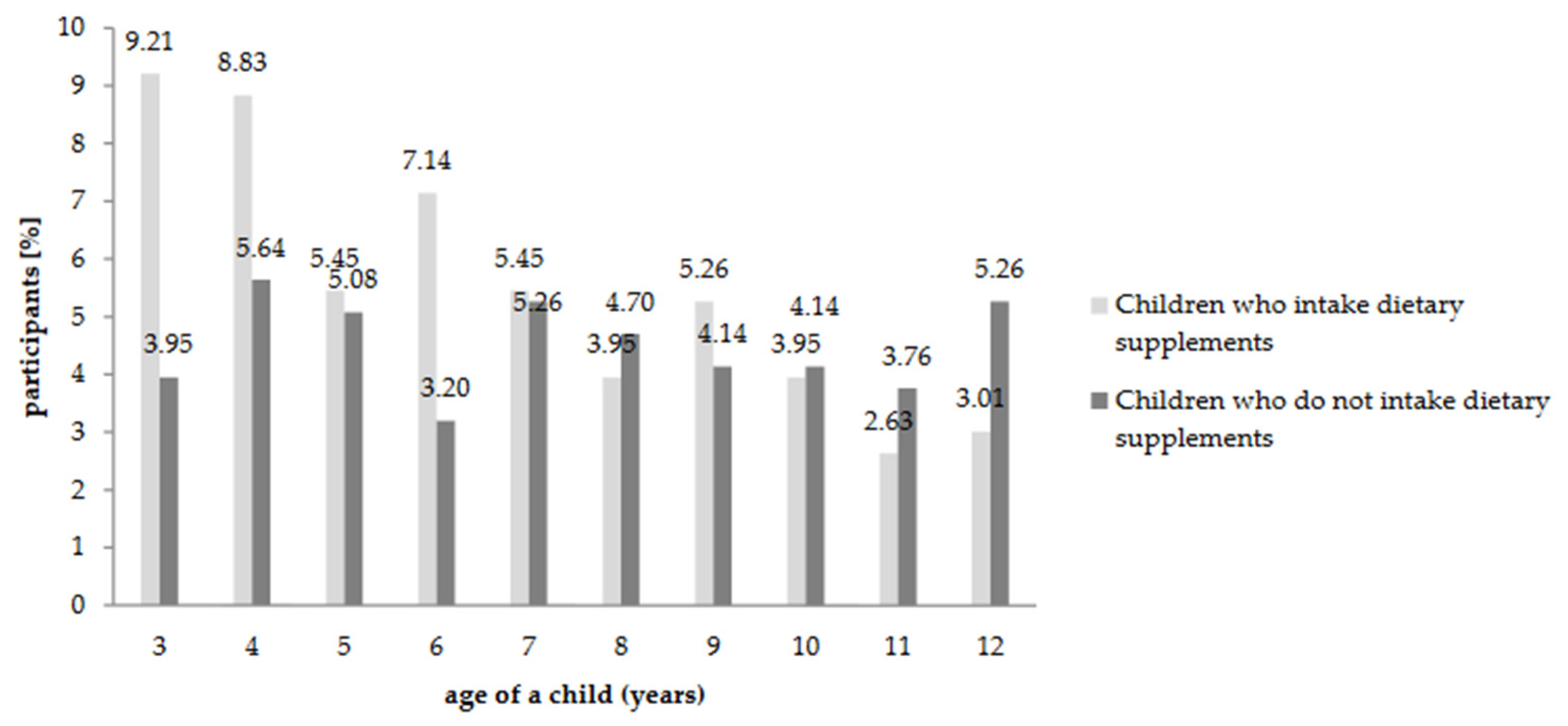
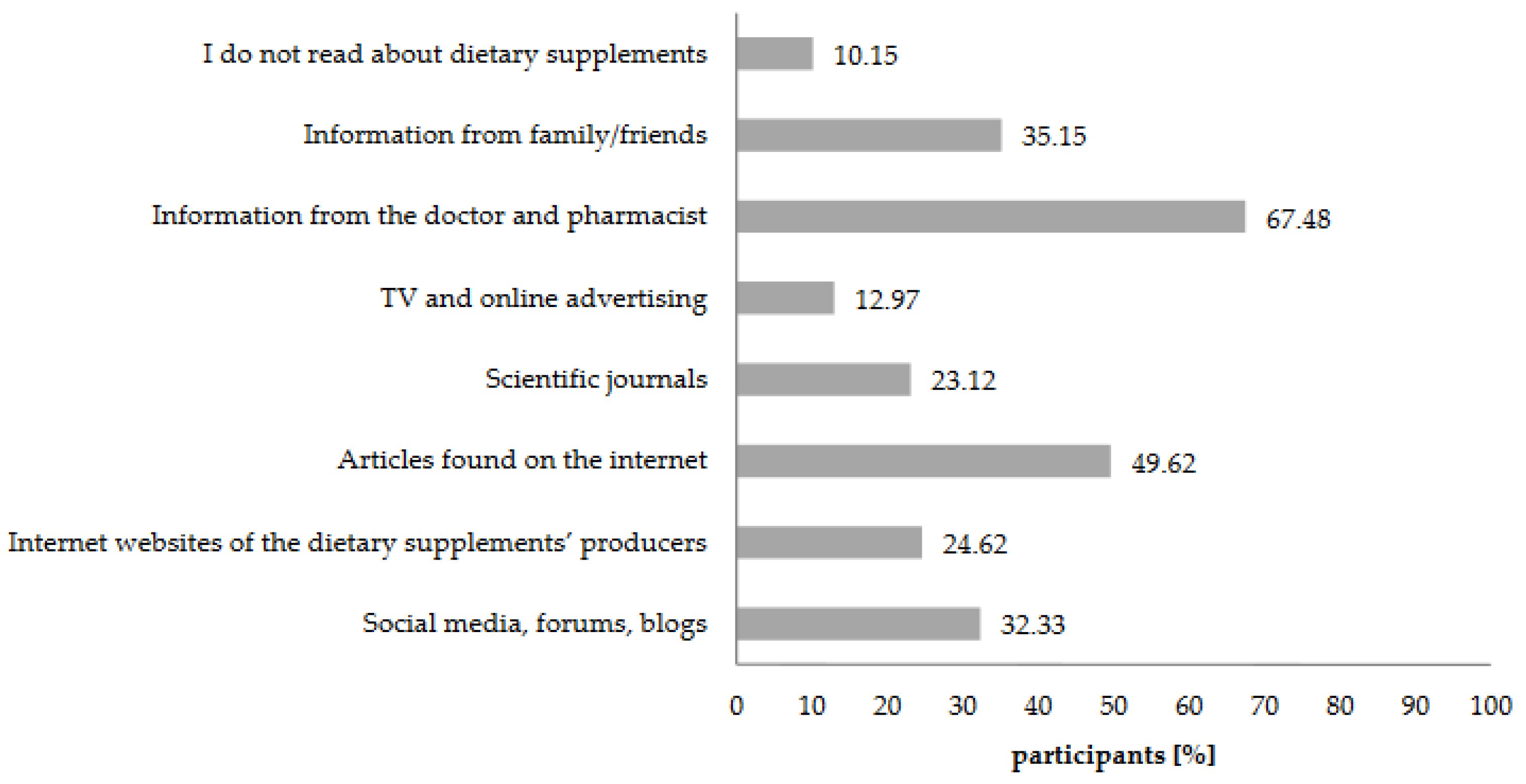
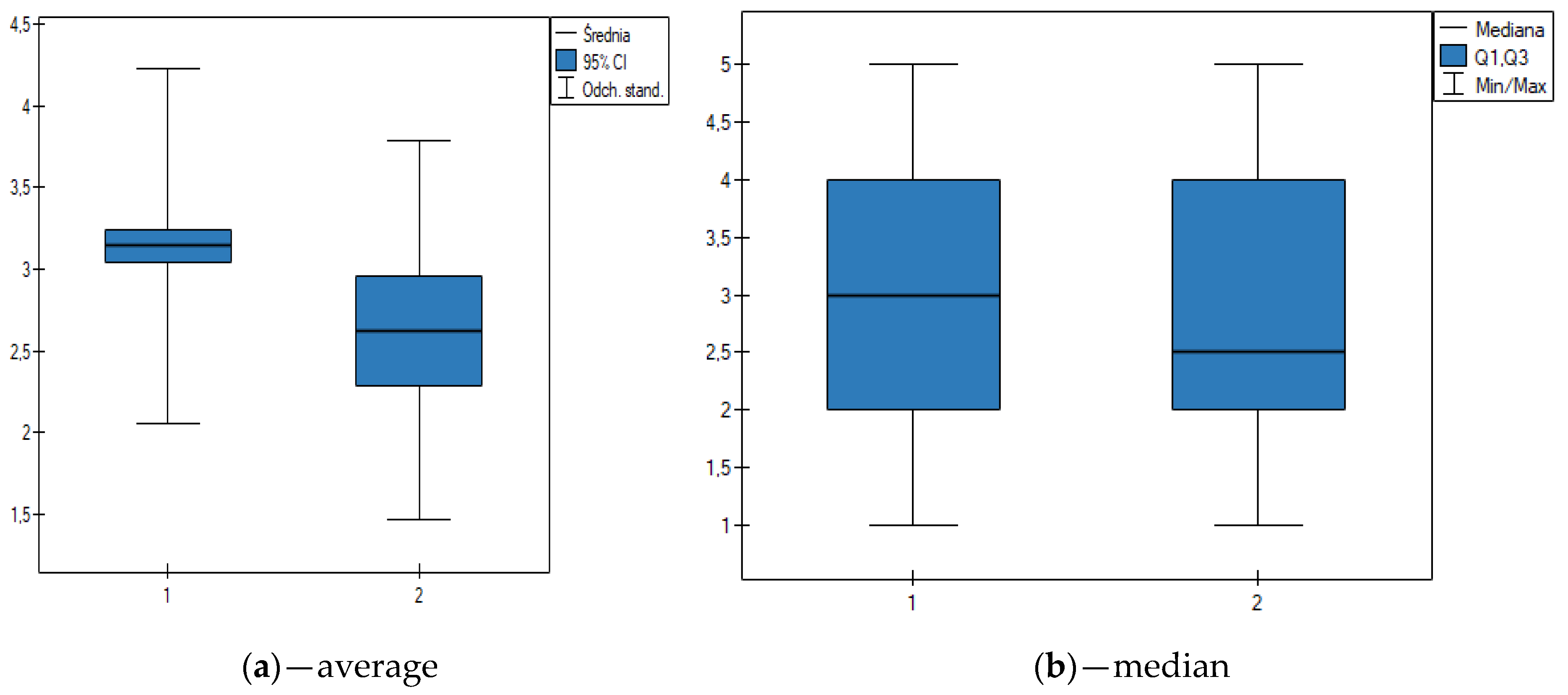
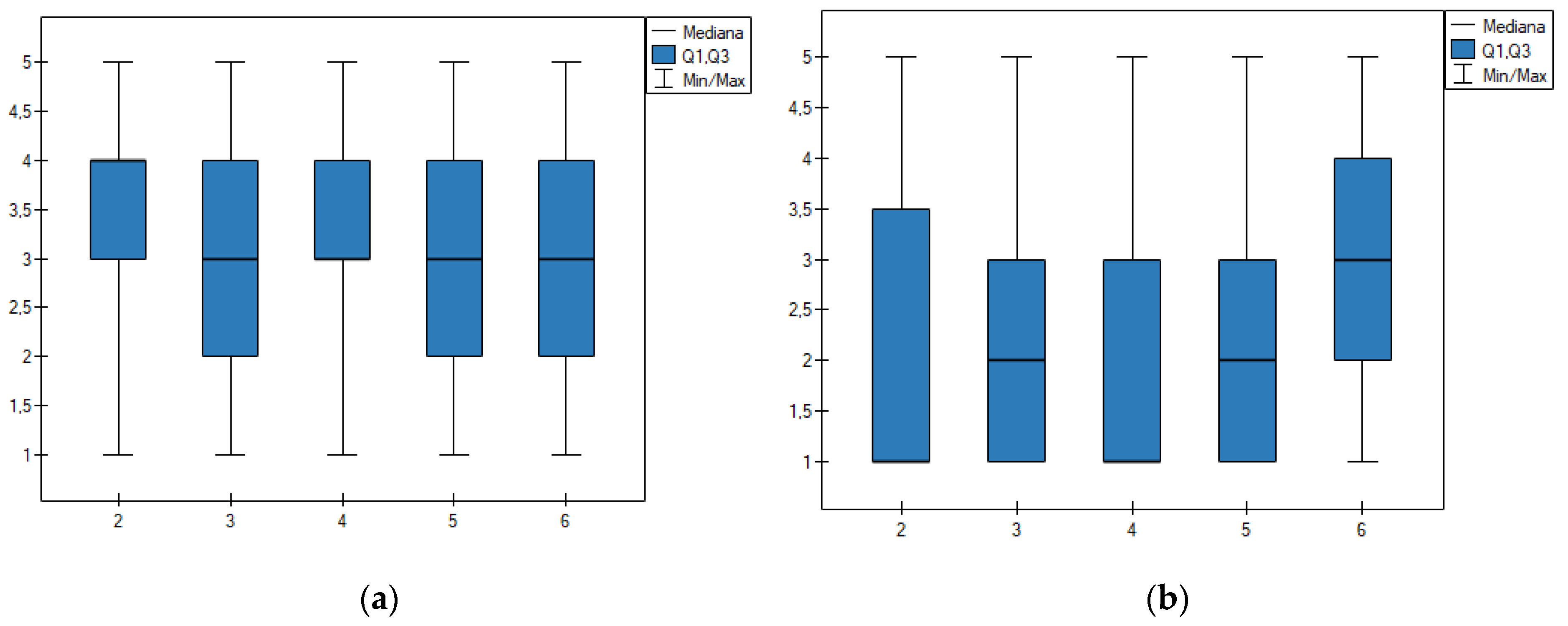
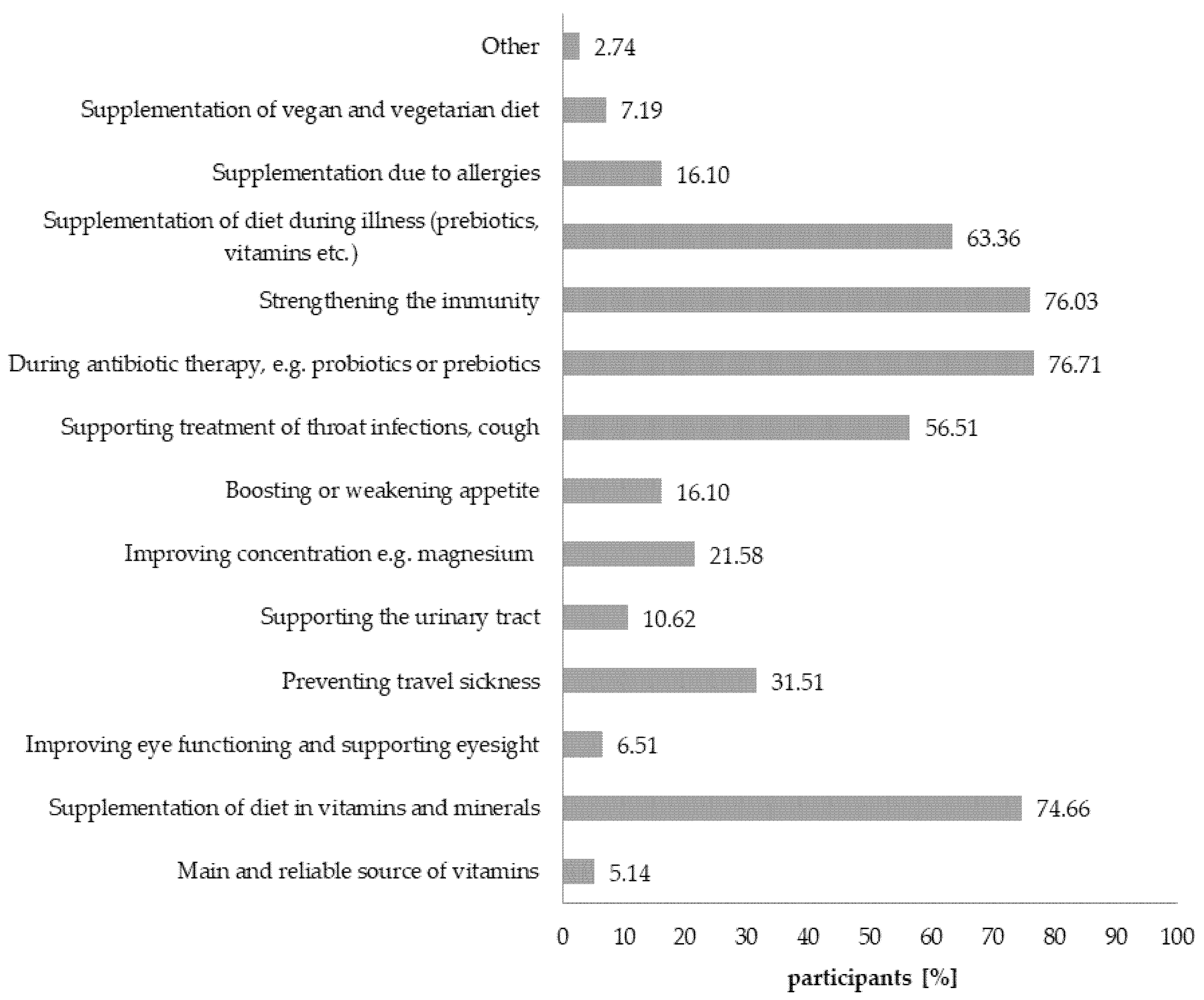
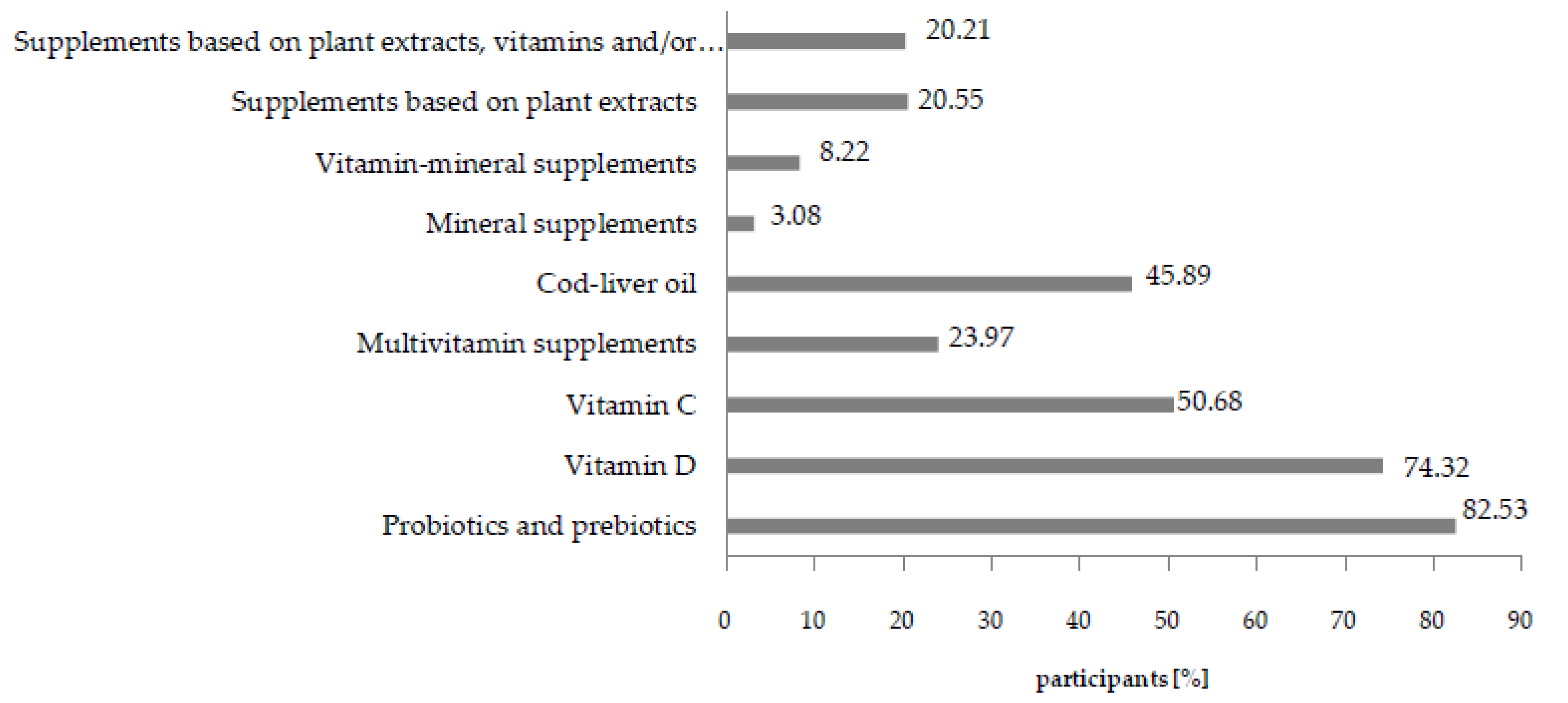
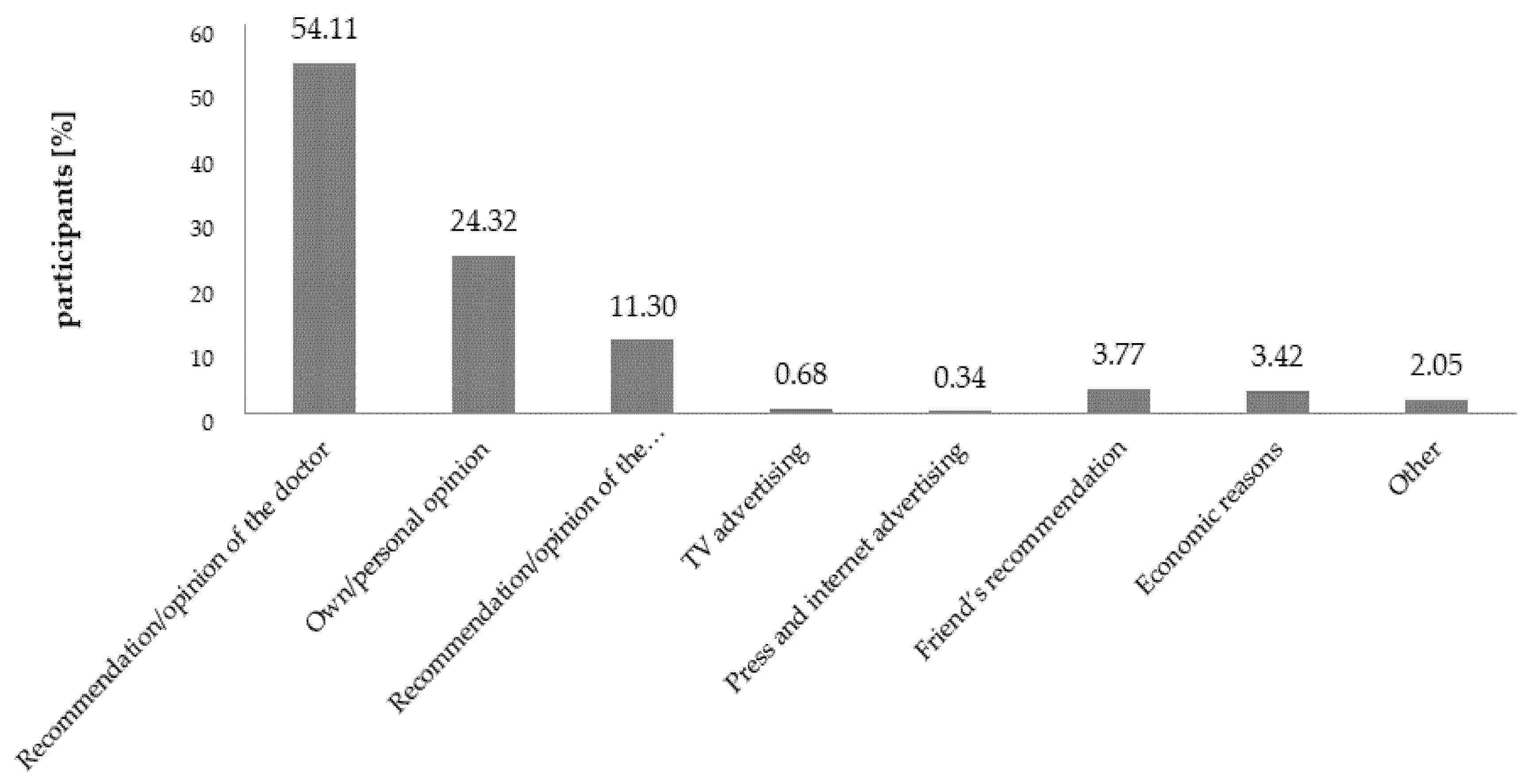
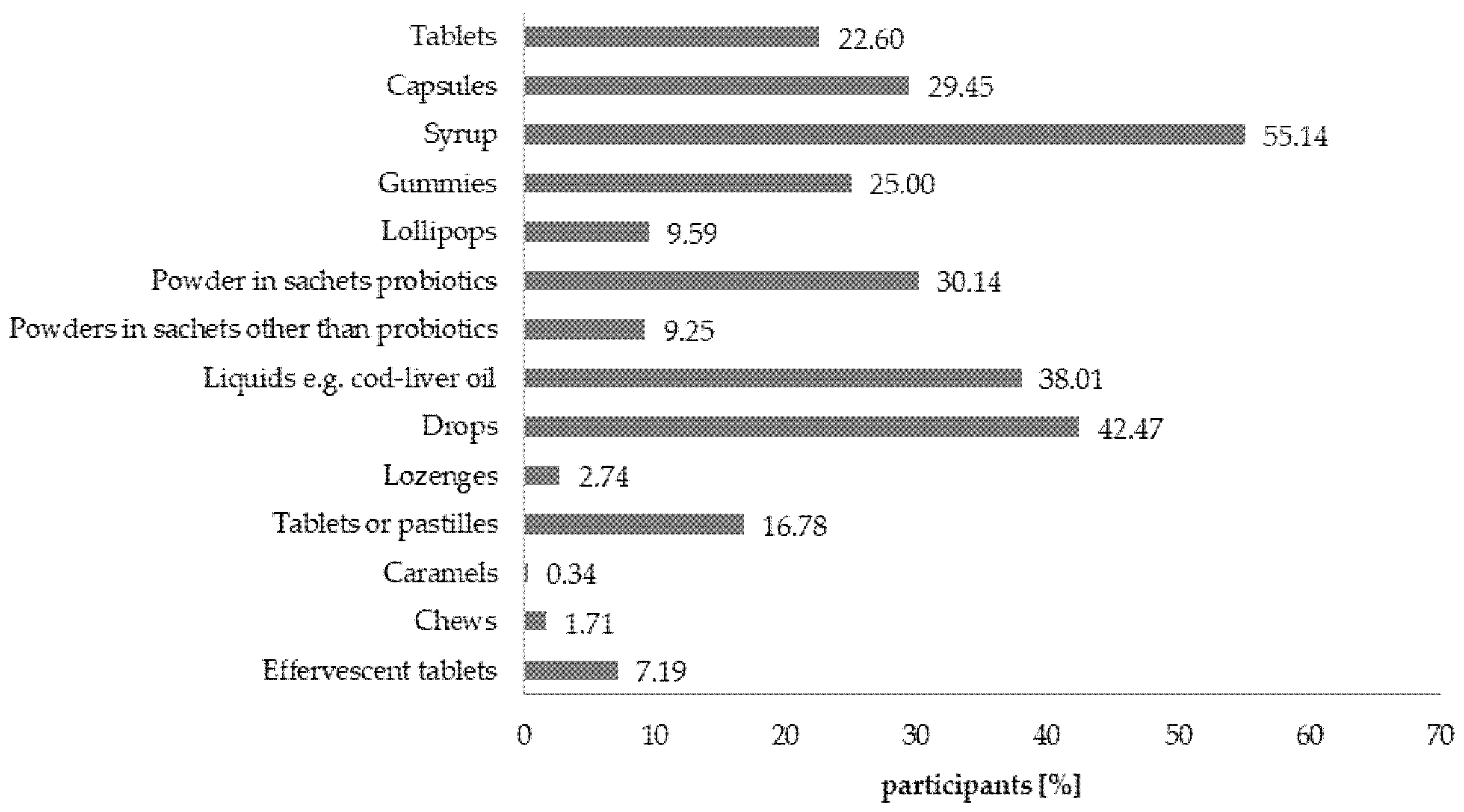
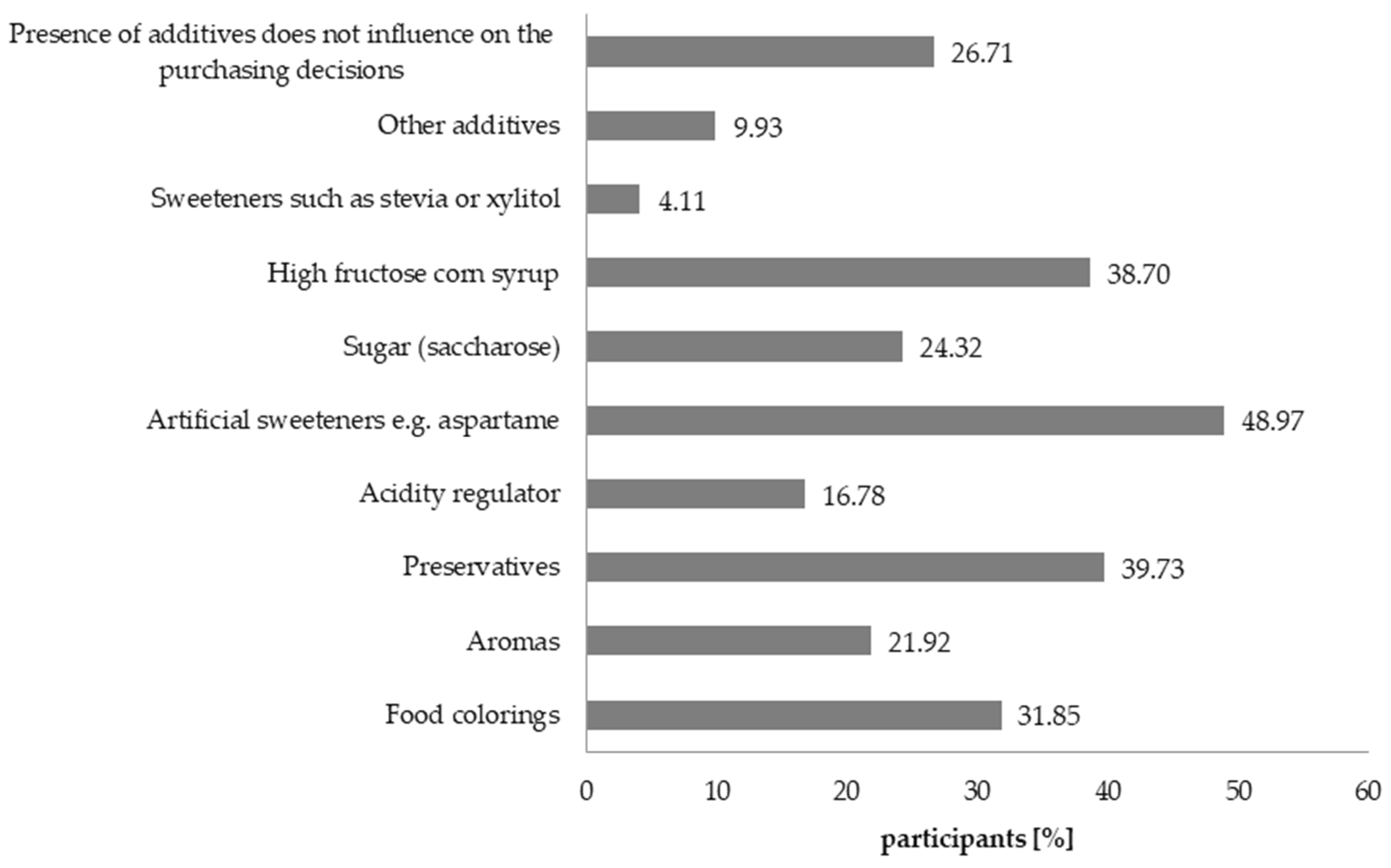

| Parameter | Entire Group N (%) | Individuals Who Intake DS n (%) |
|---|---|---|
| Gender: | ||
| Female male | 484 (90.98) 48 (9.02) | 270 (92.47) 22 (7.53) |
| Place of residence: | ||
| big city 1 town 2 village | 441 (82.89) 23 (4.32) 68 (12.78) | 241 (82.53) 10 (3.42) 41 (14.04) |
| Education: | ||
| Elementary Vocational Secondary higher | 3 (0.56) 11 (2.07) 63 (11.84) 455 (85.53) | 1 (0.34) 4 (1.37) 28 (9.59) 259 (88.70) |
| Age: | ||
| under 20 y/o 20–25 y/o 26–30 y/o 31–35 y/o 36–40 y/o 41–45 y/o 46 and more | 0 (0.00) 4 (0.75) 40 (7.52) 182 (34.21) 181 (34.02) 105 (19.74) 20 (3.76) | 0 (0.00) 4 (1.37) 21 (7.19) 109 (37.33) 102 (34.93) 49 (16.78) 7 (2.40) |
| Material situation: | ||
| very good good sufficient bad | 111 (20.86) 362 (68.05) 57 (10.71) 2 (0.38) | 63 (21.58) 194 (66.44) 34 (11.64) 1 (0.34) |
| Number of children: | ||
| one two three four five | 165 (31.02) 294 (55.26) 63 (11.84) 9 (1.69) 1 (0.19) | 89 (30.48) 171 (58.56) 27 (9.25) 4 (1.37) 1 (0.34) |
| Pharmaceuticals | Neutral | Food |
|---|---|---|
| Pharmaceuticals containing macro- and micro-elements or vitamins which are taken with the intention of supplementing the diet deficient in such ingredients. It’s a medical product that is not a medicine. Medications aimed at supplementing the diet. Medical products supplementing the everyday diet with vitamins and microelements used in order to supplement or prevent from deficiencies. Medication containing minerals and vitamins. Over the counter medication that has not been tested. ‘Medications’ which list as their ingredients vitamins and minerals essential for maintaining good health and which are supplementing the diet Over the counter medications. Ersatz medications that do not require carrying out tests before they are introduced into the market Medical product the effects of which are not scientifically proven | Tablets Artificial additives Synthetic vitamin equivalent Body strengthener Supplementation Supporter Additive Taking vitamins in the form of tablets Pharmacy preparation described as dietary supplement Preparations that are an additional support for our body Preparations that do not have the status of medication, are not medical products Measures used to support normal growth and development | Supplementation of diet Nutrient that supplements the diet which can be deficient in it Foodstuff which supplements deficiencies Something that supports nutrition Something that supplements diet Something that can replace healthy food Everyday nutrition additive Low-calorie product which replaces food Foodstuffs which contains vitamins, minerals, Omega-3 Fatty Acids etc. Supplementation of daily diet of a child Vitamins and minerals that can serve as a diet replacement Low-calorie product which can replace food Healthy food replacement |
| Nb. | Statement 1 (S) | Overall N = 532 | Administering DSs to Children | |||||||
|---|---|---|---|---|---|---|---|---|---|---|
| Yes n = 292 | No n = 240 | |||||||||
| Mean | Median | 4 and 5 [%] 2 | Mean | Median | 4 and 5 [%] 2 | Mean | Median | 4 and 5 [%] 2 | ||
| 1. | I have general knowledge on the subject of dietary supplements intended for children * | 3.48 | 4 | 50.75 | 3.62 | 4 | 58.90 | 3.31 | 3 | 40.83 |
| 2. | In my opinion dietary supplement is an equivalent of medication | 1.56 | 1 | 6.39 | 1.60 | 1 | 6.51 | 1.53 | 1 | 6.25 |
| 3. | Dietary supplements are foodstuff (type of food) | 2.29 | 2 | 23.68 | 2.26 | 2 | 21.92 | 2.29 | 2 | 25.83 |
| 4. | Dietary supplements (ingredients of dietary supplements) can interact with medication and food consumed by the child | 4.20 | 5 | 76.50 | 4.12 | 4 | 75.34 | 4.29 | 5 | 77.92 |
| 5. | Dietary supplements can cause side effects in children * | 4.03 | 4 | 71.24 | 3.86 | 4 | 66.44 | 4.23 | 5 | 77.08 |
| 6. | Taking dietary supplements in recommended doses is safe for the health of children * | 3.10 | 3 | 36.84 | 3.54 | 4 | 55.14 | 2.54 | 3 | 14.58 |
| 7. | Administering dietary supplements to children can be one way of supplementing their diet * | 2.84 | 3 | 36.65 | 3.25 | 4 | 50.68 | 2.36 | 2 | 19.58 |
| 8. | Taking dietary supplements in an uncontrollable manner (by children) can lead to an overdose of vitamins and minerals or other substances | 4.56 | 5 | 90.23 | 4.56 | 5 | 90.75 | 4.56 | 5 | 89.58 |
| 9. | Dietary supplements intended for children can have medicinal properties * | 3.05 | 3 | 36.84 | 3.34 | 3 | 47.60 | 2.73 | 3 | 23.75 |
| 10. | Selected dietary supplements intended for children are effective in flu and cold prevention * | 3.32 | 3 | 46.24 | 3.69 | 4 | 62.33 | 2.90 | 3 | 26.67 |
| 11. | Taking dietary supplements (by children) during illness can shorten its duration. | 3.36 | 3 | 48.31 | 3.67 | 4 | 61.30 | 3.06 | 3 | 32.50 |
© 2020 by the authors. Licensee MDPI, Basel, Switzerland. This article is an open access article distributed under the terms and conditions of the Creative Commons Attribution (CC BY) license (http://creativecommons.org/licenses/by/4.0/).
Share and Cite
Piekara, A.; Krzywonos, M.; Kaczmarczyk, M. What Do Polish Parents and Caregivers Think of Dietary Supplements for Children Aged 3–12? Nutrients 2020, 12, 3076. https://doi.org/10.3390/nu12103076
Piekara A, Krzywonos M, Kaczmarczyk M. What Do Polish Parents and Caregivers Think of Dietary Supplements for Children Aged 3–12? Nutrients. 2020; 12(10):3076. https://doi.org/10.3390/nu12103076
Chicago/Turabian StylePiekara, Agnieszka, Małgorzata Krzywonos, and Monika Kaczmarczyk. 2020. "What Do Polish Parents and Caregivers Think of Dietary Supplements for Children Aged 3–12?" Nutrients 12, no. 10: 3076. https://doi.org/10.3390/nu12103076
APA StylePiekara, A., Krzywonos, M., & Kaczmarczyk, M. (2020). What Do Polish Parents and Caregivers Think of Dietary Supplements for Children Aged 3–12? Nutrients, 12(10), 3076. https://doi.org/10.3390/nu12103076






